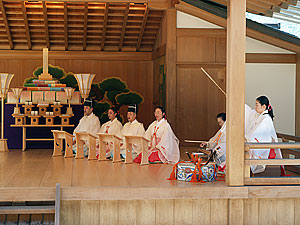Ritual and myth
an encounter with ‘divine madness’
By Bill Roberts
During his stay at Oomoto in autumn 2006, Bill Roberts gave this speech at the Hokuriku (Kanazawa) branch on Dec. 3, and variations of it earlier at the Harima (Himeji) and Wakayama branches. Some explanatory information has been added for non-Oomoto readers.
Konichiwa. Bill Roberts des. Yoroshiku. Onegaishimasu.
Thank you for inviting me to Hokuriku. I have lost count of how many Oomoto branches I have visited over the years, but I’m sure it is more than a dozen.
Most of my previous branch visits were for research for my book, “A Portrait of Oomoto.” As you know, it was published earlier this year by Tenseisha Press. A Japanese translation is now appearing serially in Matsugokoro, the monthly magazine published by the Oomoto Headquarters Youth Division. Each installment is also posted on the Jinrui Aizen-kai home page.
I was asked to talk about some of my experiences at Oomoto. Since my first visit in April 1999, I have spent a total of nearly two years at Oomoto, including 14 months writing the book.
I thought I would share my thoughts about your rituals and why I believe these are extremely important. Specifically, I will reflect on Tsukinamisai (monthly service), Setsubun Grand Festival and the pilgrimage to the island of Meshima. Oomoto followers know more about these rituals than I do. So I will keep my description of them to a minimum and mostly talk about how these rituals affected me.
I hope you will find it interesting to hear how one person from the West, who grew up in the Judeo-Christian tradition, experienced these events. I am no scholar or expert, but in my opinion, these rituals illustrate some of the traits that make Oomoto special, maybe unique among today’s religions. In a world that often seems out of control with greed, power and violence against man and nature, humankind needs ritual practices like those performed at Oomoto.
I have been especially impressed by the way Oomoto ties its rituals to its central myth. The word “myth” can be used pejoratively to mean “an unfounded or false notion.” That is not how I mean it. “Myth” also means “a traditional story rooted in historical events that explain the beliefs of a certain people.” A “myth” can also be a parable or allegory that gives us direction in life, usually spiritual direction. These are the two ways I use the word “myth.”
I have read some of the ancient Shinto myths, but when I refer to Oomoto’s central myth, I mean the much more recent story of Nao and Onisaburo Deguchi, the Foundress and Co-Founder of Oomoto. The wonderful thing is, this myth is a well documented historical reality and is full of symbolic power.
Personally, I found that Oomoto’s ritual and myth serve to create awe and gratitude for the things that should be sacred and holy in our world no matter what god you believe in.
The importance of the arts
There are many reasons why Oomoto inspires me and touches me deeply. Among these are your interfaith work, your belief that all religions come from the same source and your commitment to environment and other peaceful causes. These are absolutely essentially in our chaotic 21st century. But it was your commitment to the arts that first brought me to Oomoto.
I came with my ceramics teacher and a group of artists from Santa Cruz, California. My teacher, Coeleen Kiebert, had attended Oomoto’s traditional arts seminar in the mid-1980s. But that was not her first visit to Oomoto.
A decade earlier, in the mid-1970s, she visited Oomoto soon after she heard about the exhibit, “The Art of Onisaburo Deguchi and His School.” One of the exhibit’s venues was the Grace Cathedral in San Francisco, which is not too far from Santa Cruz, where Coeleen lives. Ironically, she heard about the exhibit too late and missed it. But the people at Grace Cathedral told her someone had written a book in English about Oomoto and they had copies for sale.
The book was Frederick Franck’s “An Encounter with Oomoto.” Franck died earlier this year at his home in New York, but not before he got to see my book. Well into his 90s, he was in ill health and nearly blind. He did not have a chance to read the book, but I am grateful he saw it because his book had inspired me in my own work. He wrote a beautiful letter telling me how much Oomoto had meant to him and that it made him happy that some other Western writer had finally been able to spend more time exploring Oomoto than he had. I think he stayed a month at Oomoto about 30 years ago to write his short treatise.
Nearly 30 years ago Coeleen read Franck’s book and soon after she went to visit an American friend who lived in Japan. While in Japan she contacted the Oomoto International Department, and was able to visit Kameoka and Ayabe for a couple of days.
Coeleen had long believed that art could and should be done as a spiritual practice, but with rare exceptions she found little support for this way of thinking in America. In America, art is prized more for its aesthetic or commercial value. Art and religion have a long history together, but in the past two or three centuries art has become less tied to religion and more an aspect of popular culture. This is certainly true in the West and I suspect true in Japan.
Onisaburo Deguchi declared emphatically that art is a Way to God for every human being, not just for specialists. So at Oomoto, Coeleen finally felt validated for her notion that art could be a spiritual practice for anyone, and from that point on she was able to teach art from a spiritual perspective.
I began to study ceramics with Coeleen in 1998. She often talked about this idea of art being a spiritual Way. She also mentioned a Shinto group where many of the priests practice the arts, anyone can be a priest and everyone is encouraged to practice the Japanese arts. She was referring to Oomoto, of course. By the time she announced she was taking a group of students to Oomoto, I was fascinated by this idea of art as a spiritual practice and I had to go see for myself. We came in April 1999.
The importance of nature
The funny thing is, what I remembered most from that first visit wasn’t the art. Oh, the calligraphy, ceramics, tea ceremony and Noh dance were memorable. But what really made the biggest impression on that first trip was Tsukinamisai, the monthly service, which I attended in the Banshoden, the main shrine in Kameoka.
I have attended religious services in many denominations all over the world, but I have rarely seen ritual as colorful and dramatic as Tsukinamisai. This ritual is poetry to my eyes, ears and heart.
Most of my branch visits coincided with their Tsukinamisai. One reason I like to visit branches is that I enjoy seeing how they perform the ritual. I think the smallest number of priests I ever saw was three. That was at the tiny branch in Nagasaki. At two branches, Choshu (Yamaguchi) and Kameoka, I saw the ritual performed entirely by women priests. At the Tottori branch I saw men and women serve as priests together.
There has been a sea bream included in kensen (the offering) at every branch, but only once did they give me the head of the fish to eat for naorai (the meal after the service). That was in Izumo.
I even saw children perform Tsukinamisai at the Children’s Festival in 2005.
In my opinion, one of Oomoto’s great strengths is that anyone can be a priest. The rituals can be learned and performed by anyone who is interested. The rituals are not some mysterious thing that only an elite few are allowed to do. Just as Onisaburo declared that art is not a Way only for specialists, your ritual is not performed only by professionals.
During my branch visits, when I did interviews for my book, I often heard the same story from followers: “I like Oomoto because I like being a priest.” The opportunity for anyone to be a priest makes Oomoto unusual – perhaps rare -- among religions. It gives Oomoto an egalitarian quality that I have not seen in other religions.
Over the years, I came to see Tsukinamisai not only as religious ritual but as its own art form. Here’s how I summed it up in my book: “From the entrance of the priests, accompanied by yakumogoto music, until they exit an hour later, Tsukinamisai, like all Oomoto rituals, is poetry, prayer, color, music and motion, choreographed in a mythopoeic pageant that evokes ancient images, expresses profound gratitude and inspires awe.”
Tsukinamisai especially cultivates a deep appreciation of nature. Kensen is just one example of this. I am not aware of any ritual in the Judeo-Christian tradition that exalts the sacredness of daikon or Chinese cabbage by blessing them on the altar!
I may be different from most Americans, but the connection between nature and Oomoto ritual resonates deep in my inner being. That’s because I understood the spiritual value of nature long before I encountered Oomoto, and long before I understood the spiritual value of art.
When I was a child, my family lived in Europe because my father was a career Army officer. We were stationed in France and Germany for more than three years. I did my first trekking at age ten in the Swiss Alps. I was 13 years old when my father retired from the Army, and we moved to Monterey, California. As a teenager and young adult, I explored the coastal mountains of California’s Big Sur wilderness. I also hiked and climbed in Yosemite Valley and the Sierra Nevada mountains in eastern California.
From the beginning, I felt at home in the mountains and I also felt special spirits there that I would later equate to your kami (divinities). In wild places I felt the presence of God much more than in the Methodist Church of my youth. I felt the peace and harmony of nature, and trembled at its awesome power and pervasive spirit. When Shinto says there is kami in all natural things, I understand it deep in my bones. Your rituals, especially Tsukinamisai, help followers consciously make the connection between kami and nature.
We have nothing like this connection in the Judeo-Christian tradition. In fact, according to our Bible, God gave man “dominion” over nature. The first pages of our Bible recount the Judeo-Christian creation myth. In one verse (Genesis 1:28) it says: “And God blessed man and woman, and God said to them, ‘Be fruitful and multiply, and fill the earth and subdue it; and have dominion over the fish of the sea and over the birds of the air and over every living thing that moves upon the earth.’ "
“Subdue” and “dominion” are the key words. The dictionary defines “subdue” as “to conquer and bring into subjection,” and it defines “dominion” as “supreme authority.” Historically, Christians have interpreted these lines to mean God gave humans the power to use nature anyway we see fit, no matter what the consequences. Today, in light of the environmental problems the planet faces, many Christians are questioning this traditional interpretation, arguing that man must become a good caretaker of nature. Yet some Christians stick to the old interpretation.
At any rate, there is no ritual that I know of in Christianity that promotes harmony between humans and nature the way that Oomoto ritual does. This is an important difference between your tradition and the dominant religious tradition in the West.
The importance of ritual
Tsukinamisai is inspiring, but I found Setsubun to be a unique experience, especially the first time I attended in 2005. I also attended last year but was busy signing books most of the night.
Before I attended Setsubun the first time, I read about it, saw photos and interviewed participants. One member of the International Department staff explained each aspect of Setsubun from the trip the chief priest makes to the top of Mount Hongu to the bean throw at the end of the long night.
(Setsubun is a prayer ritual for purification, which lasts about 10 hours, from 6 in the evening until the wee hours of the morning.)
I came to see Setsubun as an important collective performance. Each person plays a part. The ritual is bigger than any one individual and could not be performed without the participation of all. Like any effective ritual, Setsubun creates a sacred space for the participants to enact a mythic or symbolic theme, which has the potential to strike a chord deep in their consciousness. I was not prepared for the chord Setsubun struck in me.
During the second trip to the bridge to watch the priests throw hitogata (prayer papers) into the river, many images raced through my mind like a video on fast forward. Most of these images were from sacred rituals and secular ceremonies I had seen in the past. What surprised me was the next image that popped into my mind. It was a photograph taken nearly 100 years ago and half a world away from the Wachi River. It is a photograph I have somewhere at home but had not looked at in a very long time.
In the fading black and white photo, about thirty men and women gather on the banks of a muddy river in northern Texas.
This part of Texas is nothing like Ayabe (where Setsubun is held). It is a flat plain, arid and windswept, with few trees and rather bleak all in all. The people in the photo are waiting to be baptized by full immersion in the river. Baptism is a form of purification. A Christian is usually baptized only once, at the time he or she joins the church.
One hundred years ago when this photo was taken many Protestant sects performed baptism in a river, the way the Bible says Jesus was baptized. Even today, some traditional Protestant groups still do baptism this way, although most just symbolically sprinkle water on the head.
One of the stoic faces in the photo is my grandfather, probably about age eighteen. He died eight years later in the Spanish flu epidemic (1918-19), one of fifty million victims worldwide. He left a young wife with three children under the age of five and a fourth child on the way; my father was born four months after his father died.
Having this image enter my consciousness on the banks of the Wachi River at Setsubun was quite unexpected and powerful. For a few moments, I felt like I had a brief glimpse of the inner life of a man whom I never met but to whom I owe my own existence. At Setsubun, it was as if my grandfather and I were in some sacred space together and he spoke to me across the decades. He seemed to say: “Whatever else I did in my short life, on this day, on the bank of this muddy river in Texas, I committed myself to the God of my understanding.”
You could call my experience at Setsubun a product of my imagination -- and you would be right. But consider this: Science has discovered that imagination, creativity, language and religion all originate in the same part of the brain.
I realize that not everyone at Setsubun has a mysterious experience like this. Maybe some people are only there for the noodles! But, I believe the atmosphere and aura of Setsubun create the potential for feelings, images and understandings that go beyond our everyday experiences. The ritual touches something deep inside us – at least it did for me that night.
The importance of pilgrimage
The subtitle of my book is, “The Way of Art, Spirit and Peace in the 21st Century.” But I had another idea that sometimes I wish I had used instead. It was: “A spiritual adventure story.” For that is how I describe my book to Americans who know nothing about Oomoto and want some brief idea about the book I wrote. I tell them it is about my own spiritual adventure at Oomoto and about the spiritual adventures of Oomoto followers.
One of the biggest spiritual adventures I had at Oomoto was the pilgrimage to Meshima, an island in Wakasa Bay in the Sea of Japan. The island played an important role in the early days of Oomoto more than 100 years ago. In recognition of that importance, the Spiritual Leader and a small group of Oomoto followers make a pilgrimage to this island every five years. I was privileged to accompany them in July 2005. I believe I was the first non-member of Oomoto and certainly the first non-Japanese to ever attend one of the Meshima pilgrimages.
The Meshima trip became a physical and spiritual adventure. This seems appropriate, given the connection between Oomoto ritual and nature.
Because the sea was rough that day, we were not able to land our boats at the one spot where it is easiest and safest to disembark. Instead, we had to climb from the boats onto a steep cliff, and then traverse around a corner to the spot where we would pray. In doing so, we had to cross a low spot where waves were breaking. Many people got wet.
On the same spot where Nao and Onisaburo had enshrined God and prayed 100 years earlier, we erected an altar. Then the Spiritual Leader made a bowl of tea to place on the altar, and then we began the ritual, which was similar to Tsukinamisai.
To return to the boats, we had to cross over the low spot where waves were breaking. Only now the tide was rising so the waves were even heavier. Many people got wet. A few might have even been badly shaken.
On the boat trip back to mainland, we had one more ritual to perform. Halfway between Meshima and Oshima, we prayed and then the Spiritual Leader tossed small pumpkins into the sea as an offering to the Princess of the Dragon Palace of the Sea.
All in all, I had never experienced anything like this pilgrimage in my entire life. Thirty-five years ago, I made a pilgrimage to Mount Sinai, the holiest mountain for Jews and Christians. It was a long hard hike to the top, but not as treacherous as getting on and off Meshima. We prayed on the summit but no one threw pumpkins!
Pilgrimage to holy sites is an important ritual in most religions, including Christian traditions. The physical journey of a pilgrimage is usually seen as a symbolic acting out of an interior journey. For me, the trip to Meshima felt like a symbolic journey to the primordial soul of the world.
After the Spiritual Leader threw the pumpkins and we were cruising back to the port, I kept thinking about one line from the Ofudesaki (Oomoto’s Holy Scriptures), which I had read in English translation:
“As Oomoto is that which must amend this perverted spirit of the world, its followers may seem somewhat senseless or a little stupid in the eyes of present-day people. But other than such kind of people will not be in compliance with His will; therefore, to serve here daily is rather difficult.”
The case for divine madness
I thought, yes there are times, like this pilgrimage to Meshima, when Oomoto followers appear senseless or downright crazy, possessed by a kind of madness. But in a world gone crazy with greed, power and violence, what a truly divine madness you have.
“Madness” usually refers to insanity, but the idea of divine madness has been around religious and philosophical circles for centuries. The ancient Greek philosopher Plato called divine madness a gift from god. He identified four types of divine madness, all of which apply to Oomoto: prophecy, mystical rites, poetry and love of beauty. Plato lived about 2,400 years ago and the idea of divine madness was not originally his. It had existed in Greek thought for several hundreds of years. So the idea of divine madness is very old.
What I call Oomoto’s divine madness is simply the fact that you prize the importance of myth and use every means – including ritual, pilgrimages and the arts – to integrate this myth into your lives. And your myth, the story of Nao Deguchi, really happened. But, like any good myth, it also affects the emotions, beliefs and imaginations of its followers. The power of your myth intersects reality in many ways everyday at Oomoto.
Tsukinamisai, pilgrimages to Meshima, Kamishima (another island) and elsewhere, Setsubun, Utamatsuri (sacred poetry festival), monthly services at Takakuma (the cave where Onisaburo underwent spiritual training) -- these are all rituals that create awe and wonder for the sacred. We humans need ritual to connect us to the sacred, to create that sense of awe and wonder.
As important as science and rational thought are to understanding our world, we need to be reminded that there are also other ways to understand the world -- symbolic, intuitive, and spiritual ways. In the 21st century, emboldened by science and rationalism, we tend to negate these other ways of understanding. I think some of the fundamentalist fervor we have seen from many religions, especially from Christians, Jews and Muslims, is a reaction – too often a violent overreaction -- to modern man’s tendency to negate intuitive, symbolic and spiritual understanding of the world.
Especially in the West, but also I suspect in Japan outside Oomoto, many people are not even aware how much their psyche yearns for ritual and for the mystery of the sacred in life. Even many faithful Christians with strong beliefs have little in the way of ritual to nourish their psyches. I’m not a religious scholar, but I have read widely about religious practices in recent years and I would say that among Christians, the Eastern Orthodox, the Roman Catholics and the Anglicans understand the importance of ritual. They make an effort to breathe life into their faith through liturgy and ceremony, especially the communion, which symbolizes Jesus’s last supper with his 12 disciples.
Among these religions, the Eastern Orthodox seem to understand ritual the best. But the Protestant faiths, including the one I grew up in, hardly understand the importance of ritual at all. In fact, when the groups that would become known as Protestants broke away from the Catholics about four centuries ago, one of the things they revolted against was what they thought was the idolatry of Roman Catholic ritual.
Not to overstate it, but some Protestants could almost be said to be anti-ritual. Fortunately, they do have some rituals, like baptism and communion. But in their zeal to be different, I think Protestants lost sight of the importance of ritual and how it can connect us to the sacred.
At Oomoto, this is clearly something you have not lost. And you have not lost that sense of the mystical and sacred in life. Your rituals keep you ever mindful of it.
Kyo-wa watashino hanashi-o. O-kiki kudasari. Arrigato gozaimashta.
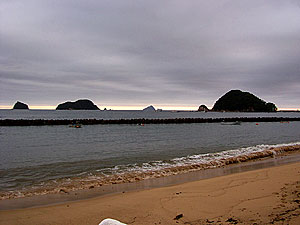
Meshima and Oshima loom in the distance.

The landing on Meshima proved treacherous.
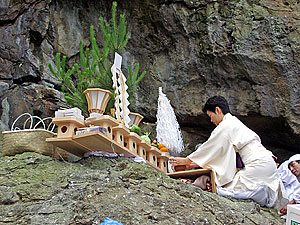
The Spiritual Leader makes tea as an offering for the altar.
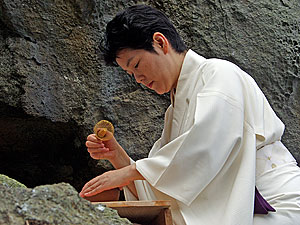
Making tea.
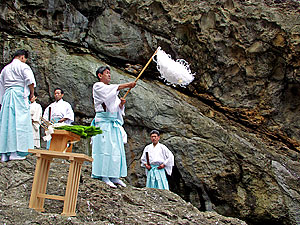
The service begins.
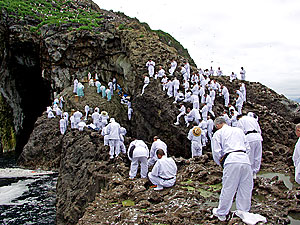
All join in prayer.
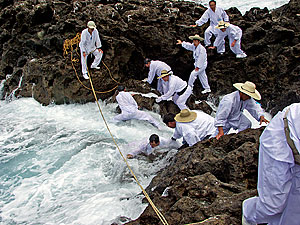
Many people were hit by waves while crossing back to the boats.
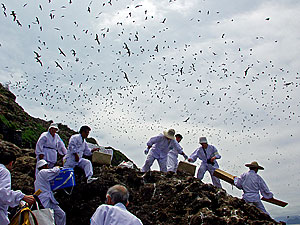
Everyone pitches in to load the boats.
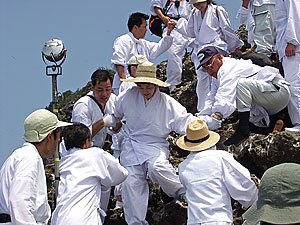
Making certain the Spiritual Leader boards safely.
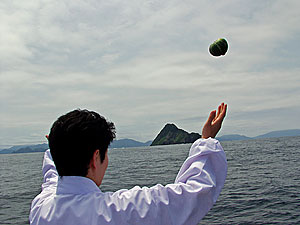
One last ritual: Offering pumpkins halfway between Meshima and Oshima.
New Contents Thu, May 20, 2010
- Oomoto participates in Sant’Egidio conference : Dialogue among religions and cultures : On divided island nation of Cyprus By Bill Roberts
- Photo Album : Portraits of three branches: Shoko, Tanegashima and Aomori By Bill Roberts
- Oomoto FAQ
- A Letter from Oomoto : Of mountains and myths By Bill Roberts
- Polyglot poem festival The Utamasturi is going international — what’s next? By Bill Roberts
- Ethics education program captures the spirit of Bankyo Dokon By Bill Roberts
- A Letter from Oomoto : A year’s worth of adventure in a summer of branch visits By Bill Roberts
- In Kumamoto, it’s all about water – and fire By Bill Roberts
- A speech by Nevada Taylor at the Kii Branch in Wakayama Prefecture on April 13, 2008.:An Encounter With Oomoto Through Aikido
- Utamatsuri, Poem Festival, in Tokyo(on April 17, 2008)
- A speech by Neil Ryan Walsh at the Kobe branch on Mar. 9th, 2008.:Planting the Seeds of the Soul
- Meeting with the Fifth Spiritual Leader of Oomoto, Madame Kurenai Deguchi by Neil Ryan Walsh
- A speech by Neil Ryan Walsh at the Nagoya branch on Feb. 17th, 2008.:The Japanese Arts beyond National Boundaries
- To the Oomoto branch in Nagoya: City of Eel and Toyota by Neil Ryan Walsh
- A Speech by Nissim Ben Shitrit, Ambassador of Israel on the occasion of the Oomoto Setsubun Grand Festival in Ayabe February 3rd, 2008 : Japan and Israel : Two Lands Balancing the Needs of Traditional Culture and Modern Life. r
- A permanent memorial to Onisaburo (A Speech at the Autumn Grand Festival , November 6, 2007 : )By James Parks Morton, Founder and Chair, Emeritus of The Interfaith Center of New York
- Israel, Palestine and the Power of Poetry(Oomoto believes small efforts can have lasting ripple effects on people and peace)By Bill Roberts
- “Something Great”(This genetics pioneer, a friend of Oomoto, offers a clue to the mystery of life)By Bill Roberts
- Kamishima Cleanup (Harima branch members regularly visit this sacred island to keep the shrine tidy)By Bill Roberts
- Kyotaro Deguchi was one of six recipients of the 2007 James Parks Morton Interfaith Award
What is Oomoto?
- What is Oomoto?
- Spirtual Centers
- Founders and Spiritual Leaders
- History
- Organization and activities
- Teachings and scriptures
- Art Works of Founders and Leaders
Opinions[Archive]
- Statement of regret for the outbreak of war against Iraq (March 20,2003)
- Jinrui Aizenkai dispatched the "Urgent Appeal for a World (Global) Crisis" on March 14.
Grappling with Bioethics[Archive]
- Oomoto’s support for abolishing the death penalty (12, June 2003)
- The Oomoto Foundation protests any birth of a human clone baby. (5, January 2003)
- OOMOTO'S VIEW REGARDING JAPAN’S PERMITION TO THE RESERCH OF HUMAN EMBRYONIC STEM CELLS (ES cells)(12, June 2000)
Vistor’s Review[Archive]
- A speech by Bill Roberts at the Oomoto branch in Hiroshima after its monthly service on March 18, 2007:Encounters with war and peace
- How Bankyo Dokon changed one life by Linda Macphee
- A speech by Bill Roberts at the Hokuriku (Kanazawa) branch on Dec. 3, 2006:Ritual and myth -an encounter with ‘divine madness’
- A speech by Bill Roberts at the Himeji Cultural Center on Feb. 25, 2007:Mesmerized by the Japanese Arts
- A speech by Bill Roberts at the Kobe branch on Feb. 11th, 2007.:There are just human tears and human joy
- A Speech on the occasion of the Oomoto Setsubun Grand Festival in Ayabe February 3rd, 2007 : Egypt's role in Middle East peace
- Keynote Speech for the 28th World Federation Japanese Religionists Conference for World Peace in Tokyo (at Kokugakuin University, Novermber 29, 2006):Vision for Peace in the Middle East By Dr. Munther S. Dajani, Professor Dean, Faculty of Arts, Al Quds University, Jerusalem
- A speech to the Kyoto branch:Spiritual adventures in researching Oomoto leaders
- A Speech at The Oomoto Foundation on Monday, November 6, 2006 : Jordan's role in Middle East By Samir Nouri, Ambassador of the Hashemite Kingdom of Jordan
- A letter from Oomoto:The Young People of Tottori
- A speech by Bill Roberts on the occasion of the dedication ceremony for the new shrine of Tottori Branch By Bill Roberts Oct. 8, 2006
- A speech by Bill Roberts at the Oomoto branch in Hiroshima after its monthly service on March 18, 2007:Encounters with war and peace
- How Bankyo Dokon changed one life by Linda Macphee
- A speech at Setsubun : A Portrait of Oomoto By Bill Roberts Feb. 3, 2006
- New Publication ! By Bill Roberts Feb. 3, 2006 A Portrait of Oomoto
you can read this book in html => http://www.jinruiaizenkai.jp/English/en-kolumno/en-bill/en-sugao/billbook1en.html
E-mail below to order brobert1@ix.netcom.com
Current Topics
- Prayer Offering and World Religious Forum II
- Living the art of dialogue
- Kyotaro Deguchi was one of six recipients of the 2007 James Parks Morton Interfaith Award
Books
Online Books
- Divine Signposts by Onisaburo DEGUCHI
- The Creation of Meaning by Hidemaru Deguchi
- Bankyo Dokon(Seventy years of Inter-Religious Activity at Oomoto)
- Nao Deguchi — A Biography of the Foundress of Oomoto
- The Great Onisaburo Deguchi published by Aiki News
- Bankyo Dokon Seventy Years of Inter-Religious Activity at Oomoto
- Insearch of Meaning
- Nao Deguchi A Biography of the Foundress of Oomoto
- A Portrait of Oomoto By Bill Roberts
Oomoto international Archive
- The History of Oomoto (Jan.– Mar. 1980 — Apr.– Jun. 1982)
- The Ancestors; Friends or Foes? (Apr.– Jun. 1987)
- Tsukinamisai; The Sabbath of Shinto (Jan.– Jun. 1983)
- The Poem Festival at Oomoto; An Ancient Rite Lives Again (Oct.– Dec. 1981)
- Purification of the Universe ; Oomoto's Setsubun Festival (Apr.– Jun. 1981)
Links
Flowers at Ten'on-kyo & Baisho-en (photographs)
Contact
All rights reserved : the Oomoto Foundation Produced by the Netinformational Commission
Since : Mar. 7.1998 Last Update : Thu, May 20, 2010
E-mail : webmaster@oomoto.or.jp
Top Page Nihongo Esperanto Português Roomazi



